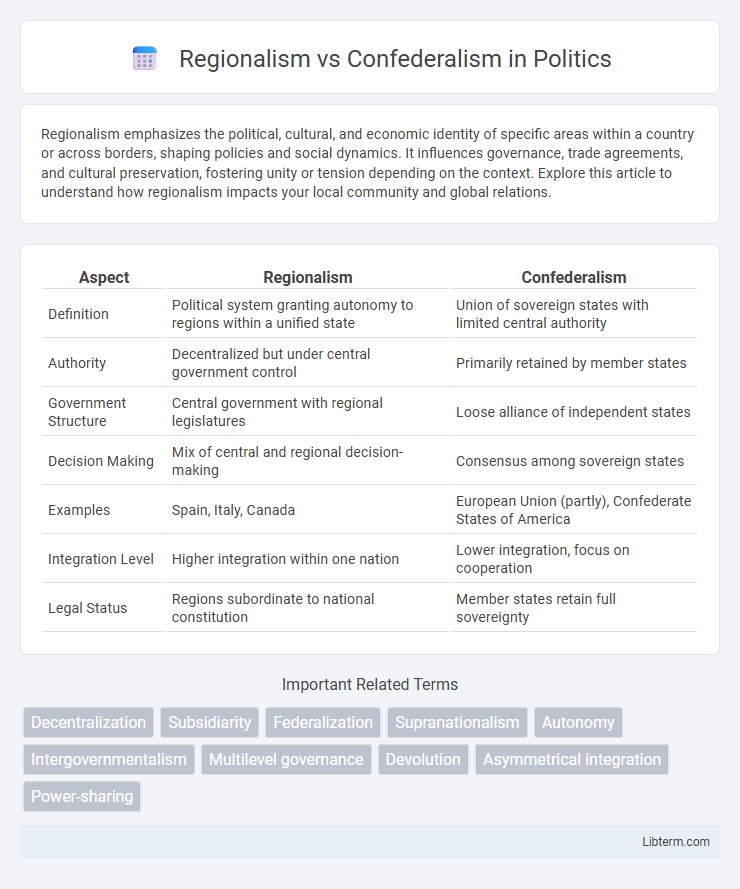Regionalism emphasizes the political, cultural, and economic identity of specific areas within a country or across borders, shaping policies and social dynamics. It influences governance, trade agreements, and cultural preservation, fostering unity or tension depending on the context. Explore this article to understand how regionalism impacts your local community and global relations.
Table of Comparison
| Aspect | Regionalism | Confederalism |
|---|---|---|
| Definition | Political system granting autonomy to regions within a unified state | Union of sovereign states with limited central authority |
| Authority | Decentralized but under central government control | Primarily retained by member states |
| Government Structure | Central government with regional legislatures | Loose alliance of independent states |
| Decision Making | Mix of central and regional decision-making | Consensus among sovereign states |
| Examples | Spain, Italy, Canada | European Union (partly), Confederate States of America |
| Integration Level | Higher integration within one nation | Lower integration, focus on cooperation |
| Legal Status | Regions subordinate to national constitution | Member states retain full sovereignty |
Understanding Regionalism: Definition and Key Concepts
Regionalism refers to the political ideology and practice aimed at strengthening the economic, cultural, or political ties within a specific geographical area, often to enhance regional autonomy or cooperation. It emphasizes shared identity, governance, and resource management among member regions while maintaining their distinctiveness within a larger political framework. Key concepts include regional integration, decentralization, subsidiarity, and the balance between local authority and national sovereignty.
Unpacking Confederalism: Foundations and Principles
Confederalism is a political system where sovereign states or regions maintain primary authority while delegating limited powers to a central body for specific functions like defense or foreign policy. Its foundations rest on voluntary association, preserving the autonomy of member states and emphasizing cooperative governance without overriding local sovereignty. Confederal principles prioritize decentralization, mutual consent, and the protection of regional identities over centralized control seen in federal or regional structures.
Historical Evolution of Regionalism and Confederalism
Regionalism and confederalism have evolved historically as responses to the balance of power between central authority and local autonomy. Regionalism emerged prominently in the 19th and 20th centuries, driven by cultural, economic, and political factors within nation-states seeking decentralized governance. Confederalism traces its roots to early political unions like the Articles of Confederation in the United States and the Swiss Confederation, emphasizing a voluntary alliance of sovereign states with limited central authority.
Structural Differences: Regionalism vs Confederalism
Regionalism involves a centralized authority granting limited powers to regional governments while maintaining overall sovereignty, whereas confederalism is a union of sovereign states that delegate specific functions to a central body without relinquishing their independence. In regionalism, decision-making is typically more hierarchical, with the central government holding supremacy over regional entities. Confederalism emphasizes the autonomy of member states, allowing them to retain full control over most policies and cooperate through agreed-upon common institutions.
Political Power Distribution in Regional and Confederal Systems
Regionalism allocates political power to subnational units within a single sovereign state, allowing regions significant self-governance while maintaining central authority in the national government. Confederalism, by contrast, disperses political power more extensively as independent states or entities voluntarily cooperate, retaining ultimate sovereignty and granting limited powers to the central confederalJi Gou . This distinction determines the locus of legal authority, with regionalism emphasizing integration under a unified government and confederalism emphasizing decentralization and autonomy of member units.
Economic Implications: Regionalism vs Confederalism
Regionalism promotes economic integration by fostering shared markets, harmonized regulations, and coordinated development policies among member states, enhancing trade efficiency and investment flows within the region. Confederalism allows greater economic autonomy for member states, which often leads to fragmented markets and varied fiscal policies, potentially limiting cross-border economic cooperation and scale economies. The choice between regionalism and confederalism significantly impacts economic stability, with regionalism encouraging collective economic strategies while confederalism prioritizes individual state sovereignty over unified economic planning.
Case Studies: Successful Examples of Regionalism
Regionalism thrives in cases like the European Union, where member states maintain sovereignty while benefiting from economic integration and political cooperation, showcasing a balance between regional unity and national autonomy. The Association of Southeast Asian Nations (ASEAN) exemplifies successful regionalism by promoting economic growth, peace, and stability among diverse countries through consensus-driven decision-making. The East African Community (EAC) demonstrates regionalism's effectiveness in fostering trade liberalization and infrastructural development to enhance regional connectivity and economic performance.
Examining Real-World Confederal Systems
Confederalism features a political structure where sovereign entities delegate limited powers to a central authority, maintaining significant independence, as observed in the Swiss Confederation and the European Union's early framework. Regionalism emphasizes decentralization within a single sovereign state, promoting regional governance to enhance local autonomy and cultural identity, exemplified by Spain's autonomous communities. Examining real-world confederal systems reveals challenges like coordination complexity and limited central power, contrasted with regionalism's focus on balancing unity and regional diversity within a nation-state.
Challenges and Criticisms of Both Governance Models
Regionalism often faces challenges such as uneven resource distribution and intensified localism, leading to weakened national unity and difficulties in implementing uniform policies. Confederalism is criticized for its limited central authority, which can cause inefficiencies in decision-making, lack of enforcement power, and vulnerability to fragmentation as member states prioritize sovereignty over collective interests. Both governance models struggle with balancing autonomy and cohesion, creating persistent tensions between local control and the effectiveness of overarching governance structures.
The Future of Intergovernmental Relations: Regionalism or Confederalism?
Regionalism emphasizes cooperative frameworks among states or provinces within a nation, promoting shared governance and economic integration while maintaining national sovereignty. Confederalism advocates for a loose alliance of sovereign entities that delegate limited powers to a central authority, prioritizing autonomy over centralized control. The future of intergovernmental relations hinges on balancing efficient policy coordination through regionalism against the preservation of state independence embodied in confederal structures.
Regionalism Infographic

 libterm.com
libterm.com